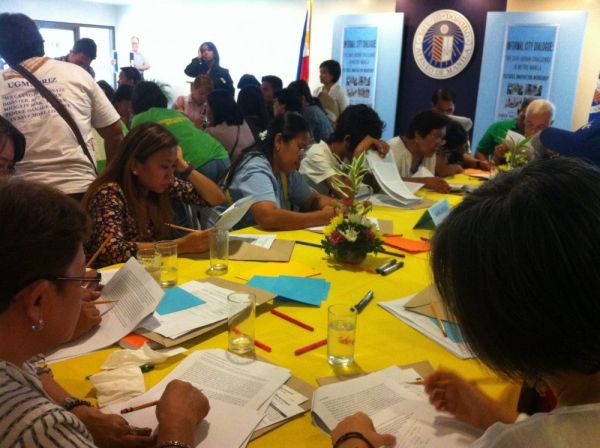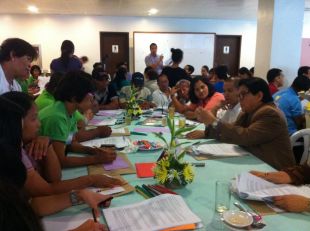A Plan for Communities Built Locally and Sustainably With ‘Sweat Equity’

Participants debated a range of proposals, from an underground community to a neighborhood that hovers over water.
Jessica Dator-Bercilla of the Ateneo School of Government (ASoG) offered a simple piece of advice to the Innovation Workshop participants: Look at how ants work. They labor side by side to build their kingdom together, their “sweat” (if they had sweat) shared equally, as if to imply that no ant should be left behind. “They are the best communicators,” she said, and an example of inclusiveness and resilience.
This spirit, which had also guided the Metro Manila Futures Mapping Workshop in March, in which participants had imagined different possible scenarios for Manila in the year 2040, continued to inspire the participants at the Inclusive Futures Innovation Workshop in April. The series of workshops was organized by Innovations for the Base of the Pyramid in Southeast Asia (iBoP-Asia), the Inclusive Mobility Project of ASoG and Forum for the Future with the support of The Rockefeller Foundation, and were part of Rockefeller’s Informal City Dialogues project, with ASoG as the local partner and Forum for the Future providing technical and strategic advice.
In the Futures Mapping Workshop, participants had imagined four possible outcomes for Manila’s future: One in which fast population growth is paired with effective urban planning and development, another in which fast population growth coincides with ineffective urban planning and development, a third in which slow population growth accompanies effective urban planning and development, and finally, one in which slow population growth occurs alongside ineffective urban planning and development.

From 17 proposals, a plan for “self-sustained and self-reliant communities” was voted up.
But if the aim of that workshop was to imagine possible futures for Manila, the goal of the Innovation Workshop was to use those imagined futures to spur innovation ideas that could start to improve the lives of the people of the city today. To this end, even the most radical, novel and creative solutions were nurtured, encouraged and evaluated. To change Manila, or to even imagine that Manila is capable of change, was for some in attendance a radical idea itself. Many of the participants come from urban poor communities where rivers are pungent and black, and where shelter is sometimes no more than a 20-square-meter house consisting of boxes, old tires and posters of movie stars.
But the workshop participants believed it was possible. And so a mix of government personnel, representatives from the private sector, volunteers and members of civil society — all leaders in their own right — set out to create the innovations that could create change for the better.
For instance: An underground community, hidden in plain sight, with dark green foliage serving as its “roof.” People would travel downwards to reach their homes. It sounded like Atlantis without the ocean or the mythical tragic ending.
“There will be solar cells and that’s where we will get power,” said Rene, a resident of one of the city’s slums, in a tone authoritative enough to silence any naysayers. The solar cells will be placed above a canopy of vegetables and fruits grown hydroponically, a method of planting without soil. There will be an area for breeding poultry, which will be a source of income for those living below the poverty level. Waste will be turned into biomass for fertilizer.
Here’s another one: Fully developed communities — complete with transportation, health and educational facilities, and agricultural space — will be constructed above waterways. The group that proposed this called these developments “hanging communities.”
“If Mars is an alternative dwelling place for the human race, it is more possible for us to build a hanging community,” insisted the group’s members, Alarcio, Monforte and Silva, all residents of Manila.
These were but a few of the ideas bandied about by participants who were asked, first and foremost, whether a resilient and inclusive Manila is possible. And, if so, what would be the environmental, institutional, social, economic and physical aspects of such a city? What sort of innovations could help create resilience and inclusivity by avoiding the challenges and seizing the opportunities that appeared in the future scenarios?

Eight of the 17 proposals addressed housing rights for informal settlers, a major issue in Manila.
To help them conceptualize these concepts, the participants were given two metaphors for inclusivity and resiliency. A more inclusive Manila is akin to fabric that is woven — different materials are intertwined to form one durable item. There is emotional investment and connection in the process. An eagle’s nest, on the other hand, represents resiliency. “Even if it takes many generations, an eagle could fly back to his nest and see it still intact,” said Dator-Bercilla.
Guided by these ideas, the four groups huddled together and discussed what resiliency and inclusivity would mean for Manila. After almost an hour, they wrote down on colorful post-its the following: In a resilient Manila, there would be diminished need to see residents try their luck in other places abroad. People would pay their taxes on time. The Pasig River, which is polluted and clogged with garbage, would be healthy, clean and safe. There would be zero casualties when disasters strike because climate change adaptation has been mainstreamed. Buildings could withstand strong earthquakes.
The ambitions went on: There would be bike lanes. People with disabilities would not be discriminated against. Business process outsourcing — one of the top sources of income for young people in Manila today — would be replaced with knowledge outsourcing, which requires a more advanced set of research and technical skills.
One group said, in three words: “Everyone is united.” That’s what an inclusive and resilient Manila is.
The groups agreed, however, that change would not come easy, primarily because of two classic stumbling blocks: Corruption and lack of political will. Hence, when the participants chose, from 17 proposals, the plan to create “self-sustained and self-reliant communities” as the innovation to submit for a Rockefeller Foundation grant, they also devised ways to prevent corruption from impeding the project.
“Self-sustained and self-reliant communities,” which was conceptualized by local leader Filomena Cinco along with her group members, aimed to promote the principles of ownership and stewardship by allowing communities to be hands-on in every step of the process of designing and building their houses.
They also incorporated “sweat equity” into the concept, meaning the people would “pay” for the house by building it themselves. Materials to be used would be indigenous. After 50 years, the residents would be required to move out of the building. (Engineers at the workshop said this proposal was sound because buildings are often not habitable anymore after 50 years unless rehabilitated).
To prevent the misuse of funds, the groups recommended that an internal monitoring mechanism and an anti-corruption community watchdog be put in place. Community audits would also be conducted.
The other proposals were wide ranging and included a plan to push for zero waste in Metro Manila through closing dumpsites and encouraging composting, facilities and services for pregnant women, and tourism infrastructure that’s more accessible to people with disabilities. Eight of the 17 proposals addressed housing rights for informal settlers and the need for land tenure. In the end, the vote for “self-sustained and self-reliant communities” paved the way for a deeper discussion of the housing problem in Manila.
Government authorities in the workshop indicated that they are open to policy reforms with regard to socialized housing, and participants created a seven-member steering committee to oversee the development of the proposal with the help of ASoG and government agencies.
Architect Jun Palafox, an urban planner in attendance, said reforms should happen sooner than later. “Why would we wait until 2040?” he asked. “Metro Manila’s heart is in trouble and it needs a bypass surgery. Why postpone the surgery when it can be done sooner?”
Photos by Purple Romero









